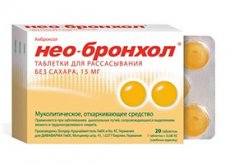Medical expert of the article
New publications
Preparations
Neo-bronchol
Last reviewed: 04.07.2025

All iLive content is medically reviewed or fact checked to ensure as much factual accuracy as possible.
We have strict sourcing guidelines and only link to reputable media sites, academic research institutions and, whenever possible, medically peer reviewed studies. Note that the numbers in parentheses ([1], [2], etc.) are clickable links to these studies.
If you feel that any of our content is inaccurate, out-of-date, or otherwise questionable, please select it and press Ctrl + Enter.

Neo-Bronchol is a mucolytic with expectorant effect.
It stimulates the activity of serous cells located in the bronchial mucosa, thereby increasing the volume of mucous secretions and changing the imbalance of serous and mucous elements within the sputum. As a result, the action of hydrolyzing enzymes is activated and lysosomal release from Clara cells is potentiated. Such effects can significantly reduce the viscosity of sputum.
Indications Neo-bronchodilator
It is used in cases of respiratory tract damage, in which the formation and secretion of viscous sputum is observed (chronic bronchitis in combination with broncho-obstruction, bronchial asthma, as well as bronchiectasis).
 [ 1 ]
[ 1 ]
Release form
The drug is released in the form of lozenges - 10 pieces inside a blister pack. The package contains 2 such packs.
Pharmacodynamics
The active ingredient of the drug is ambroxol, which increases the volume of surfactant inside the lungs. This occurs due to the increase in its binding and release inside the alveolar pneumocytes, and in addition to this, with the disruption of its decay processes.
The component ambroxol increases the mucociliary movement of sputum, which helps to slightly reduce the cough.
Pharmacokinetics
When administered orally, ambroxol is almost completely absorbed in the gastrointestinal tract. In blood plasma, Cmax values are observed after approximately 0.5-3 hours. The drug does not accumulate. Synthesis with plasma protein is 90%.
After parenteral or oral administration, ambroxol is distributed at high speed within tissues (the highest rates are observed within the lungs). The drug can cross the BBB and placenta, and is secreted with breast milk.
Conjugation ensures intrahepatic metabolic processes of drugs. In this case, metabolic components are formed that do not have therapeutic activity.
The half-life of the drug is approximately 7-12 hours. Ambroxol is excreted through the kidneys (90% in the form of a metabolic element, and approximately 5% in an unchanged state).
In individuals with severe CRF, a significant prolongation of the half-life is observed.
 [ 2 ]
[ 2 ]
Dosing and administration
The lozenges must be slowly dissolved. For the age group of 6-12 years, the dosage is 1 lozenge 2-3 times a day (30-45 mg of the drug). Teenagers from 12 years of age and adults need to take 2 lozenges of the drug 3 times a day during the first 2-3 days (90 mg of the substance per day).
At times, when required (as prescribed by a doctor), the dose of the medication can be increased – taking 2 lozenges 4 times a day.
Without a doctor's prescription, Neo-Bronchol can be taken for a maximum of 4-5 days. If further treatment is required, it is necessary to consult a physician.
Use Neo-bronchodilator during pregnancy
During the 1st trimester, Neo-Bronchol cannot be taken. In the 2nd and 3rd trimesters, it can only be prescribed after the attending physician has assessed all possible risks and benefits.
Because ambroxol is excreted in breast milk, breastfeeding should be discontinued during therapy.
Contraindications
Main contraindications:
- ulcers affecting the gastrointestinal tract;
- a convulsive syndrome of various origins;
- severe intolerance associated with ambroxol or additional components of the drug.
The drug is used with extreme caution in cases of severe stages of pathologies affecting the kidneys or liver - in such cases, reduced dosages are administered or the time interval between drug use is prolonged.
Side effects Neo-bronchodilator
The main side effects that appear during therapy are:
- immune disorders: signs of intolerance (rashes or itching, urticaria and Quincke's edema) are occasionally observed;
- gastrointestinal tract lesions: sometimes nausea, abdominal pain, vomiting or diarrhea appear;
- systemic manifestations: fever, weakness and headaches.
Overdose
The use of high doses of ambroxol did not result in signs of poisoning. Occasionally, short-term agitation and diarrhea were recorded.
In cases of extreme intoxication, the following symptoms occur: gagging and vomiting, hypersalivation, and decreased blood pressure.
Symptomatic actions are taken. Emergency measures (induction of vomiting and gastric lavage) are not necessary; such schemes are used only in cases of extreme overdose.
Interactions with other drugs
When the drug is administered together with antitussives, the weakening of the cough leads to complications in the removal of sputum, which is why such a combination is used only under strict indications.
Ambroxol can increase the levels of antibiotics (amoxicillin with erythromycin, as well as cefuroxime) in bronchopulmonary secretions and sputum, potentiating their passage into the secreted secret.
Shelf life
Neo-Bronchol can be used for a 3-year period from the date of manufacture of the therapeutic agent.
Application for children
The medication is not prescribed to persons under 6 years of age due to its high ambroxol content.
Analogues
The analogs of the drug are Bronhorus, Mukobron, Ambrobene and Halixol with Ambrolor, as well as Lazolvan, Diphlegmin, Ambroxol and Flavamed with Ambrosan. In addition, the list includes Ambrolan, Remebrox, Bronchoxol and Lazongin.
Attention!
To simplify the perception of information, this instruction for use of the drug "Neo-bronchol" translated and presented in a special form on the basis of the official instructions for medical use of the drug. Before use read the annotation that came directly to medicines.
Description provided for informational purposes and is not a guide to self-healing. The need for this drug, the purpose of the treatment regimen, methods and dose of the drug is determined solely by the attending physician. Self-medication is dangerous for your health.

